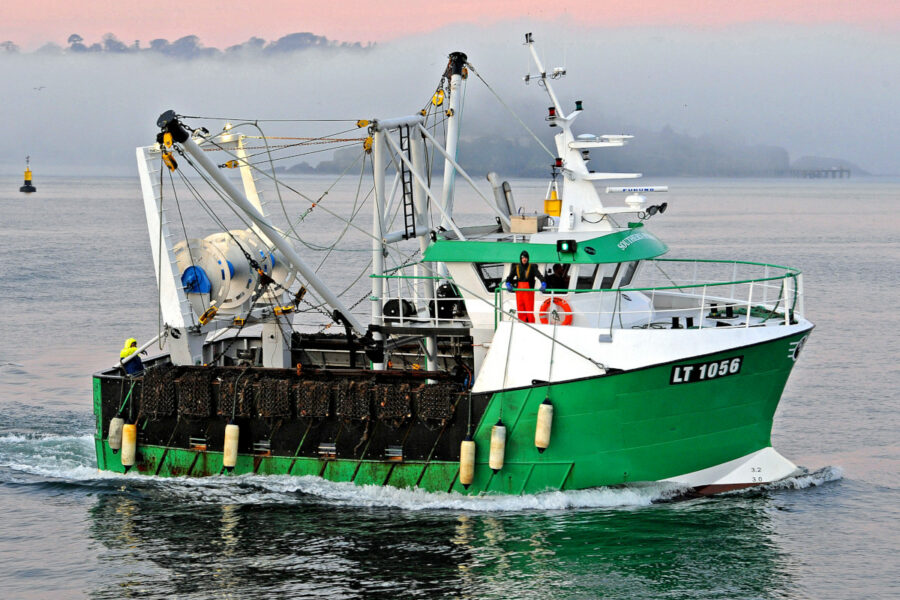An impressive £17,500 maiden trip provided early validation of the owners’ decision to invest in a modern and versatile ‘big’ 15m scalloper. Phil Lockley reports
The gross figure from a good trip on a 30m beam trawler can be eye-watering, but its true net profit may be somewhat less. Big boats can be fuel-hungry, reckons the skipper of the new 15m scalloper Southern Spirit LT 1056.
On new-build 15m towing boats, the gap between gross and net profit may be much smaller, ‘bringing better wages for those working aboard, and over the long term, better returns for its owner’, said skipper Carl ‘Friday’ Snell.
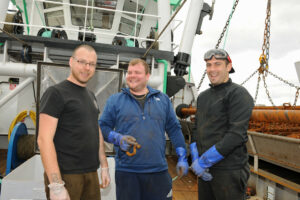
The crew of Southern Spirit, left to right: skipper Carl ‘Friday’ Snell, mate Robert Hamilton and crewman Reegan Green.
Launched recently, Southern Spirit is the fourth vessel built at C Toms & Son, Polruan, Cornwall for R&B Fishing, which has its headquarters in Lowestoft. Its fifth build from C Toms & Son – an under-10m vessel similar to the Saxon Spirit – is nearing completion.
Fishing seasonally on grounds around the South West, vessels owned by R&B Fishing operate from ports such as Brixham, Plymouth and Newlyn.
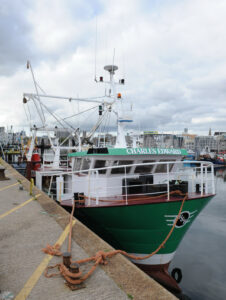
Skipper Carl Snell’s previous boat, Charles Edward, seen here alongside at Plymouth Fisheries, is now under new command.
Principally a scalloper, Southern Spirit has the option to switch to twin-rig trawling, giving it the ability to cash in on fisheries like the South Devon cuttlefish boom that occurred over the winter of 2017-18.
During the latter stages of its build, skipper Carl Snell took a significant role in deciding the layout of Southern Spirit, with efficiency and safe operation being two major factors.
Designed by marine architect Ian Paton, of SC McAllister & Co Ltd, Southern Spirit is based on a style of hull now typical on small to medium-sized steel towing boats with relatively low power. However, as it is driven by a highly efficient engine and propulsion system, with hydraulics powered from an auxiliary, it provides an impressive bollard pull compared to a traditional boat of the same length.
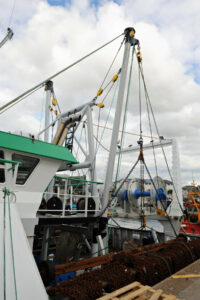
Towing from the derricks, with the towing point well ahead of the rudder stock, makes a single-rudder configuration suitable for Southern Spirit.
Reduced fuel cost is essential, said Paul Toms of C Toms & Son. “A major factor to encourage investors to buy new boats is fuel economy, no doubt about that, and engines such as the Volvo Penta D13 are often chosen.”
Comparable to Southern Spirit is the 15m scalloper White Eagle CY 525, completed at C Toms & Son for the Western Isles firm of K&K Fishing earlier this year.
The hull of White Eagle is identical to that of Southern Spirit. Both have forward-mounted engines and independent split winches – but the similarity stops there, explained Ian Paton.
He added: “With a traditional Scottish aft wheelhouse and outrigger arrangement on the White Eagle, in order to maintain good steerage it has a triple rudder system, while the Southern Spirit has a conventional single rudder system. Both steering systems operate from a single rudder stock.

Southern Spirit is rigged for scalloping and trawling.
“These hulls are a development from the lines of the Le Men Du, built by C Toms & Son in 2014. Both White Eagle and Southern Spirit are based on the same hull as the Diligent Jo LT 1045, and by having those lines below the waterline – providing the same water flow – both White Eagle and Southern Spirit are also very capable towing boats.
“Whereas Southern Spirit tows from forward derricks, making the towage point well ahead of the rudder, White Eagle tows through outriggers off the gantry and the towage point is much closer to the rudder, so a triple rudder system gives it better manoeuvrability. Both boats are fitted with forward fins to reduce pitching, and that is now standard on this range of boats. Wills Ridley supplied the steering gear on both boats.
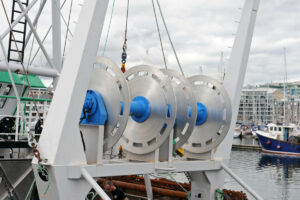
After the South Devon cuttlefish boom, it was decided that the vessel should be dual-purpose and have net drums fitted, with deck space left for a third winch.
“We are looking at the potential of offering a similar hull design with a slight increase in its beam, which may appeal to skippers considering a new build.”
Following its impressive maiden trip (Fishing News, 5 December), Southern Spirit has clocked up several successful weeks. Skipper Carl Snell and crewmen Robert Hamilton and Reegan Green were eager to try out the new boat and enjoy the comfort that it provides.
Carl Snell said: “Over the past three years, I have been scalloping for R&B Fishing, skippering its traditionally designed vessel Charles Edward FE 385.
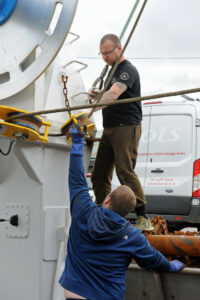
Skipper Carl Snell and crewman Reegan Green making adjustments to the Flemings Fairleads blocks, made by F&R Belbin Ltd.
“In my opinion, the ‘big’ small-boat hull of Southern Spirit is every bit as good as the seakeeping of a traditional hull, and surpasses everything we had hoped for. Southern Spirit is the best boat I have ever skippered.
“Being the son of Brixham skipper Brian Snell (Harvester BM 127), it was likely for me to become a fisherman. At the age of 16, my dad gave me two choices: go to college or go to sea, and whichever I chose, I had to work hard. I chose fishing. There was no choice, really, because I love fishing.
“I’m now 34, so I have spent a while in fishing, and have no intentions of doing anything else. I do wonder why so few young people want to join the fishing industry. It is a very rewarding job.
“I started doing deck work for my father, who then skippered the beam trawler Sara Lena BM 30. I moved to bigger boats like the Vanduck BM 362, and eventually I became a skipper and jumped in at the deep end, skippering the Harm Johannes BM 51. I then skippered the Milford Haven beamer Stephanie M 177 for just over a year, and then I moved to smaller boats.
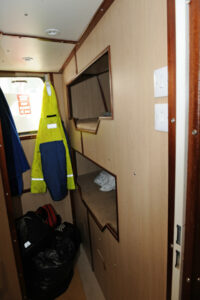
One of the two-berth accommodation spaces.
“It’s not because I didn’t like the bigger boats, but in my opinion, for both skippers and deckhands, there’s more wages achievable from smaller boats. Many other such fishermen are thinking along the same lines.
“I’m not saying that the bigger boats are not profitable, but the shares on this type of boat can be better than shares on bigger boats. Bigger boats mean bigger expenses and far less left to share.
“After a year skippering the Charles Edward, the fleet manager asked whether I would consider running a more modern boat, a 15m scalloper, and the Southern Spirit was under construction. I jumped at the chance, and from then on, I had an input into its layout.
“I saw the original drawings showing a traditional three-drum single winch, its main controls being outside – but for quite a few years, I had seen how split winches operate and what advantages there are, like full controls at a working position in the wheelhouse. Overall, they are a far better option. The winches are powerful but are relatively small, and if we go twin-rigging, there’s ample space to install a raised third winch.
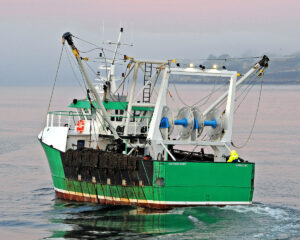
Although the hull is only 15m in length, the vessel can compete with much larger traditional boats.
“Minor changes were made to the originally planned deck layout, making it more efficient, as well as minor changes to the layout of the wheelhouse. In addition, a few changes were made in the galley area and so on, just to make life easier, because we will spend a great deal of our lives on the Southern Spirit. I’m a bit over the top on cleanliness aboard my boats, and that’s the way it will stay.
“It’s great to start with a new boat, and having a conveyor system is superb – no more kneeling down to sort out the catch. We had the height of the conveyor system raised slightly so that we stand rather than crouch – again, making life easier.
“C Toms & Son has built a really good boat, and it is amazing what designer Ian Paton can put into a 15m boat. It’s not a big boat, but it has the efficiency and comfort of a much bigger traditional boat.
“The first few trips, we stayed on familiar ground and fished
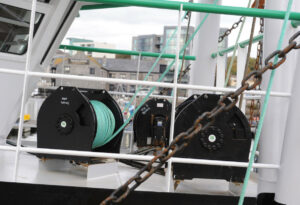
The ‘hydraulic compact’ tipping and topping winches were made by TMA Winches in Italy and supplied by Hercules Hydraulics.
with the Charles Edward, giving us the chance to shake down and see that everything was working properly – but other than changing a few minor things like the position of a couple of lugs, everything was just right. If the returns are good, we may stay in the same or similar areas for a while – but the whole idea of having such a boat is to work further afield for longer.
“We can go to 10 dredges per side, but will use mainly eight dredges a side to remain within byelaws. The fuel tanks hold 10,600 litres and we have 12,800 litres of freshwater, so if necessary, we could do a trip of 10 days, but that is unlikely. We will keep the quality of the catch as high as possible, and work shorter trips. We do have a superb refrigeration system made by Alpino Services, and we may in future have an ice machine fitted.
“As far as seakeeping is concerned, we are very pleased. No boat of this design will ever turn in the same distance as a traditional hull – the Charles Edward could spin around on a penny – but we gain so much more with the hull design of Southern Spirit. However, for better manoeuvrability in harbour, at a later date we may have a bow thruster fitted.”
New builds from C Toms
Based at the scenic Cornish port of Polruan, C Toms & Son has considerable experience in the construction of advanced designs from SC McAllister & Co Ltd, being so familiar with the construction of those designs that the build-time is reduced.
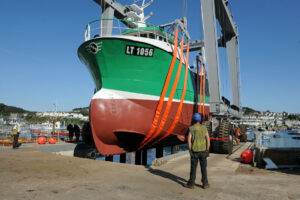
Southern Spirit being lowered into the water at Polruan.
Boss of the yard Paul Toms said: “About two years ago, initial discussions to build the Southern Spirit took place, principally as a scalloper. At first, the opportunity of twin-rigging wasn’t really considered. However, that coincided with seeing excellent returns made from the cuttlefish boom off South Devon. If an unexpected boom in a non-quota stock like cuttlefish were to happen again, R&B Fishing wanted to be able to take part, so we have fitted the appropriate net drums. By having split winches, there’s plenty of deck space ahead for a third winch to be fitted; it would be fairly simple to do that job, and the hydraulics necessary have already been installed.
“Being the fourth boat that we have built for Roger Klyne, the owner of R&B Fishing, we know what Roger expects from a boat, and what options he is likely to choose to make it more efficient. In terms of layout, the Southern Spirit isn’t far from that of the scalloper Le Men Du FH 408, a vessel we built five years ago, but Le Men Du has a three-drum winch, while both White Eagle and Southern Spirit have split winches.
“Over the past years, I’ve spent considerable time visiting ports in Brittany, where split winches are a common choice. Roger has similar experience, and now prefers split winches on boats the size of Southern Spirit.
“Both White Eagle and Southern Spirit have a conveyor system, made by Stride Engineering, and that makes life easier. I’m confident that we could make our own conveyor system, but with Stride Engineering being close by, a firm with considerable knowledge on conveyors, we are very happy to use them.
“Each boat in this class comes from the drawing board of Ian Paton – lines that we are used to. Our men are very experienced in constructing such boats, and we can build them faster. Although the hulls are different, the general arrangements are the same. As far as the procedures in construction are concerned, the under-10m version is a shortened 12m boat, and so on – these are very ‘big’ small boats. All steel is sourced from the same place – Snijtech in Holland – and the computer-aided design for the hull forming is by Deri Jones & Associates Ltd of Machynlleth, West Wales – so it’s the same formula on all Ian Paton boats.
“Propulsion of Southern Spirit is from a Volvo Penta D13, with a Volvo Penta D7 powering the hydraulics. A Volvo Penta D5 drives the generator, but it also drives a small hydraulic retrieve pump as a backup to the D7. As well as the main split winches, there are three winches each side for topping, tipping and pull-down. On launch, the Southern Spirit weighed 106t, and with extra ballast, fuel and water, I wouldn’t be surprised at a figure of around 135t in its working state.”
John Reid scallop gear
Based at the Northfields Industrial Estate in Brixham, leading manufacturer of scallop gear John Reid & Son supplied a complete package of gear to Southern Spirit.
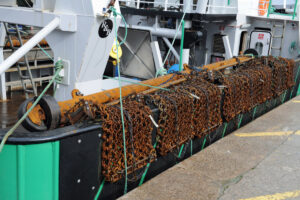
A complete package of scallop gear was supplied by John Reid & Son Ltd.
Head of the firm Jonathan Reid told Fishing News that the package included the tow bars and chains, dredges, chain bags, tooth bars and accessories – ‘everything necessary’, he said.
To reduce wear, parts of the frames are made from Hardox steel, as are the tooth bars. “Almost all skippers now consider tooth bars made from Hardox steel a standard choice,” explained Jonathan Reid.
“When we introduced the advantage of using Hardox steel, skipper Carl Snell was one of the first to try it. In our opinion, it doubles the life of a dredge, and extends the life of a tooth bar by the same amount, so it’s no surprise that he’s chosen Hardox steel again.

The crew spent several days alongside at Plymouth Fisheries preparing their new gear for the maiden trip.
“Dredges for the Southern Spirit are a lighter-weight version of those typically used on bigger boats like the beamers. They are medium-length dredges with chain bags and tooth bars made to the specifications given to us by Carl. It’s nice to see young skippers like Carl doing well – he knows exactly the specifications he wants, and has quite a few years of experience in testing gear to reach those specifications.”
For a couple of years now, John Reid & Son has been extending its hydraulic services division. In addition to supplying tailor-made hoses and components, the company will soon be supplying its own winches. Jonathan Reid explained: “Hydraulics is getting to be a bigger part of the business. We know what the loss of fishing time means, so we will respond whenever necessary. If we are told the specification of the part necessary – or the dimensions of the hose – it will be there at the quayside waiting for when they arrive.
“In our hydraulics division, we have continually invested in more space and equipment. Since starting the hydraulics service we have gained considerable experience, so making our own winches is a natural step to take. We are already working on winch designs with a couple of skippers, so we should see production by this time next year.”
Globe Marine electronics
A full package of advanced electronics equipment is fitted in the Southern Spirit. All items were supplied and installed by Globe Marine Ltd of Paignton in South Devon.
Together with his engineers, sales director Wilf Morton supplies and services electronics on a wide range of commercial fishing vessels and shipping.
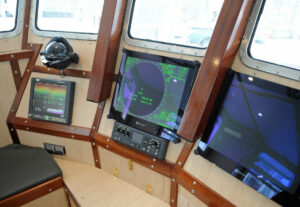
The Furuno FAR1513-BB radar – ‘a class act’, says Wilf Morton, boss at Globe Marine Ltd – and the Hondex HE7300Di echosounder.
Talking about the Hondex echosounder installed on the vessel – as specified by skipper Carl Snell – advice from Wilf Morton is that an echosounder is ‘only as good as the transducer that you put it with’, adding: “You can have the best sounder available within your budget, but saving money by having a less expensive transducer could be a big mistake.
“The Hondex HE7300Di echosounder that we installed on the Southern Spirit is a product that we have been installing for some time. We interfaced it with the Simrad Combi-C 38/200kHz transducer, which is a really good match for seabed definition.
“The HE7300Di now has its dual-frequency facility set at 38kHz/200kHz, against the traditional standard of 50kHz/200kHz. By having the frequency lowered to 38kHz, it provides a wider swathe on a single pass.
“In my opinion, another good choice from Carl is the Furuno FAR1513-BB radar, a ‘class act’ in the radar world, and perfect for this size of vessel. He has chosen a really professional array of Furuno electronics equipment, and we wish him all the best with the new boat.”
The electronics equipment onboard Southern Spirit is:
- Furuno FAR1513-BB radar
- Two Furuno GP39 colour GPS navigators
- Furuno SC70 satellite compass
- Two MaxSea TimeZero plotters
- Icom M506-GE VHF radio with GPS
- Icom M330-GE VHF radio with GPS
- Hondex HE7300Di echosounder
- Simrad Combi-C 38kHz/200kHz transducer
- Navitron NT777 autopilot
- Navitron NT920 rudder angle indicator
- Navitron NT920-WA watch alarm system
- Comar T200B Class B AIS system
- Seven Neovo X17E 17in
- TFT glass-fronted colour monitors
- Hikvision 520T CCTV system
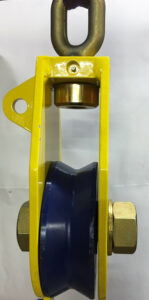
The larger of the new range of Flemings Fairleads, with a SWL of 6t.
New range of Flemings Fairleads
Manufactured to a high specification, the new range of Flemings Fairleads fitted to Southern Spirit were supplied by F&R Belbin Ltd of North Tyneside.
The new range of scallop blocks includes one with a 6in-diameter sheave and a 3t safe working load (SWL), and one with a 9in-diameter sheave and a 6t SWL, which is fitted with a link on the side as an extra safety feature. The new blocks have stainless steel bolt pins and bronze bushes.
Peter Belbin, director of F&R Belbin Ltd, said: “The new range of scallop blocks are part of our extensive range of products, including trawl blocks, rollers and scallop spanners. We can also manufacture blocks of various sizes to suit the needs of the owner.”
Alpino Services refrigeration system
The impressive refrigeration system onboard Southern Spirit was manufactured and installed by local firm Alpino Services.
Owner Alex Pino told Fishing News: “We’re based in Polruan and do a lot of work for C Toms & Son, but our scope is literally wherever fishermen want us to be. We serve vessels and new builds all around the UK, and indeed Europe.
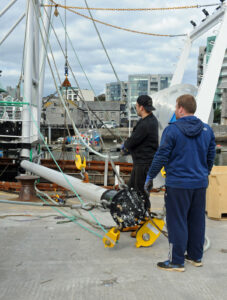
Checking the blocks ahead of the maiden trip.
“We are hoping to clinch a deal to have a second unit at Newlyn, where our work is extensive, both with the home fleet and also visiting boats.
“On Southern Spirit, the refrigeration system is in excess of the standard for that size of vessel, and typical of the ratings on current new builds for this type of vessel. Those boats are long-term investments, and the owners don’t cut corners in terms of specifications.
“Due to space constraints, the refrigeration plant on Southern Spirit is situated in the tiller flat, where space was plentiful. Refrigeration is on the deckhead and for’ard bulkhead. Locating the fridge plant in the tiller flat was actually great for us, as it meant we had a pretty free rein of location. But the added bonus was that the heat generated by the compressor helps to keep the space dry and warm.”
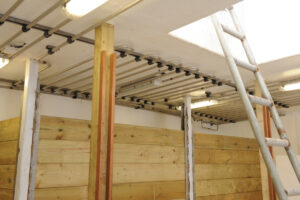
The refrigeration system in the large fishroom provides for either scalloping or trawling on Southern Spirit. The piping is fixed to the deckhead to protect against corrosion.
Refrigeration on the deckhead comprises 160m of 22mm-diameter stainless steel tube, with stainless channel and plastic clips as normal to prevent rusting or corrosion. Refrigeration on the bulkhead is provided through 45m of 16mm-diameter stainless steel piping, covered with stainless steel sheets for protection. Expansion valves and phials (gas temperature sensors) are all located in the tiller to prevent corrosion, minimising potential failure points.
An electrical control panel is situated in the engineroom, which remotely supplies the fridge plant, with engineer/emergency controls and isolators in the tiller flat. A digital controller is situated in the wheelhouse. The entire system is keel-cooled via a bespoke cooler, designed and manufactured by Alpino Services.
Alex Pino added: “The refrigeration system onboard the Southern Spirit is about as good as it gets – top of the range in all respects. Because of unseen problems raised by the installation of hydraulics and/or electrics, refrigeration engineers often have to adapt, but in this case everything went in as planned. We are very happy with it, and would like to extend our thanks to Ricky and his lads from H&H Electrical for their help in running in the electrical supply cables, to Steph and the lads from Hercules Hydraulics for giving us space and for working with us in planning, and of course to C Toms & Son for once again choosing Alpino Services.
“My staff and I send sincere best wishes to Roger Klyne, skipper Carl Snell and his crew, and hope that they have good and safe fishing.”

